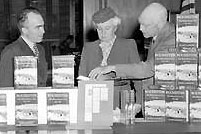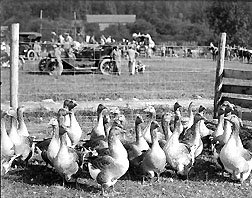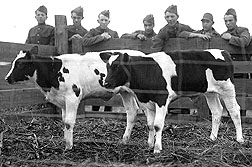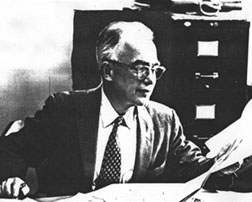Blake F. McKelvey's 1972 A History of Penal and Correctional Institutions in the Rochester Area
[McKelvey pages 22 through 24] Increasing age and mounting idleness continued to plague the county penitentiary for another three decades. The practice of loaning some inmates for maintenance work at Iola or in the Sheriff's office had to be curtailed during the Second World War when a drop in commitments compelled the penitentiary to hold its trustees for farm work. Supt. Thomas 0. Owen did send a detachment of 20 inmates into the city during the blizzard of 1945 to help collect ashes, but declining numbers confronted the penitentiary itself with a manpower shortage until the return of peace brought increased commitments. Renewed criticisms by state inspectors of the county jail as well as the penitentiary and an increasing number of escapes from both institutions prompted the county to install new locks at the penitentiary and to build a steel grill around the first tier of cells in the penitentiary to fit it for the confinement of short-termers to be transferred from the jail but kept separate from the long-term inmates in the upper tiers.
When these makeshifts failed to silence the criticisms of state inspectors, the Supervisors invited the Bureau of Municipal Research to make a study of the county's penitentiary needs. Its report, released in February 1964, stressed the fact that since the great majority of local commitments were for drunkenness, the use of drugs and other behavioral infractions, the chief need of most inmates was for rehabilitation, not solitary confinement for 16 hours a day in small antiquated cells. The Bureau's proposal that the county convert the existing buildings of its abandoned Iola tuberculosis sanitarium for use as a Rehabilitation Center to house 100 selected inmates from the penitentiary roused a storm of protest from the neighborhood. The report did prompt Superintendent Thomas F. Riley to engage Gerald J. Sullivan, formerly a parole officer, to undertake a pilot study of rehabilitation techniques at the penitentiary which upgraded the school program with the aid of volunteer instructors from the city. As director of rehabilitation, Sullivan arranged for the release of a few inmates to take part in training programs at both Eastman and Xerox, and he initiated a series of art classes at the penitentiary conducted by volunteer artists who spent three mornings a week instructing interested inmates. . . .
The county had at last come to recognize the necessity to replace both the penitentiary and the jail. Gordon Howe, who as a supervisor had moved for the creation of a new penitentiary in 1937, now in 1966 as County Manager renewed that motion only to have it tabled again. But plans were progressing for a new jail to be located in close proximity to the courts in the new civic center. The decision to house it in a six-story structure and to equip it with 324 cells on three floors, raised the possibility of combining the penitentiary with the new jail. Many advocates of a rehabilitation center offering greater flexibility in treatment in a less confining environment protested, but reports of the successful escape of 24 inmates from the aged penitentiary silenced most objectors to maximum security institutions. The transfer of the last inmates from the penitentiary as well as the old jail was completed in October 1971. With its grey steel cages, 5 by 8 by 8 in size and equipped with a bunk, a wash basin and a toilet, arranged in tiers or blocks, each with 13 cells that open onto a block corridor that serves as a lounge room by day, and monitored by cameras wired to TV screens on the administration floor, the new Monroe County jail supplies greater security to its inmates as well as to the public than any of its predecessors. As in former Monroe County jails, the correctional effects of the new jail depend on the objectives and skills of its administration. Although the penitentiary with its greater capacity for the employment and the flexible handling of inmates, was at least temporarily abandoned, rehabilitation remained, as County Manager Howe put it, in 1970, a "most important part of our detention system."
The new jail, he declared, would supply in a complex of class rooms and recreation facilities on the top floor facilities for increased instruction, counseling, and self improvement that should prove especially beneficial to the younger prisoners who were becoming more numerous in the jail population. Volunteer instructors from local colleges and other institutions who had proved so useful at the penitentiary would have greater opportunities at the new jail. A plan for the release of selected inmates for work by the day at jobs in the city, approved by the County Legislature in 1970, promised to recapture some of the correctional values of productive labor long banned from penal institutions. But whether the rehabilitation program could survive the renewed stress on security following the riots at Attica remained to be seen. |





